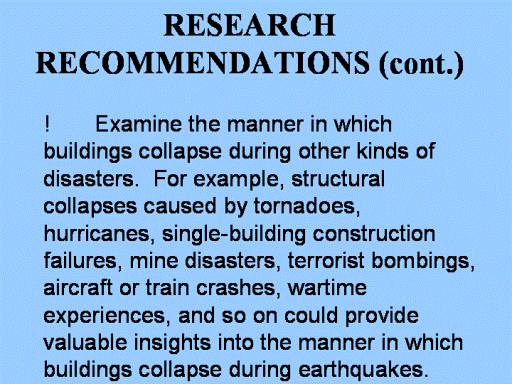| front |1 |2 |3 |4 |5 |6 |7 |8 |9 |10 |11 |12 |13 |14 |15 |16 |17 |18 |19 |20 |21 |22 |23 |24 |25 |26 |27 |28 |29 |30 |31 |32 |33 |34 |35 |36 |37 |38 |39 |40 |41 |42 |43 |44 |45 |46 |47 |48 |49 |50 |51 |52 |53 |54 |55 |56 |57 |58| review |
 |
!
Determine the risk of toxic releases and other nontraditional
hazards following earthquakes.
!
Identify the cultural and socioeconomic determinants of
earthquake injury. For
example, despite the potential hazards associated with unreinforced
masonry buildings, such buildings frequently offer the only
affordable shelter for economically and socially disadvantaged
residents and marginal minority businesses.
Therefore, we should direct research at developing
architectural, administrative, and managerial hazard-reduction
techniques that are tailored to reduce the risks of different ethnic
minorities in earthquake-prone areas of the country.
!
Attempt to determine worldwide and by country or
disaster-prone area 1) the proportion of people who are effectively
protected at that moment by aseismic buildings, both at home and in
the workplace and 2) the cost of providing complete protection for
the population in question (137).
|